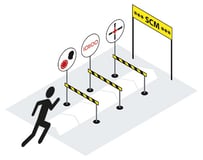Why Today’s Supply Chains Need to Think Outside the Enterprise
Robert Recknagel - April 27, 2021

The old linear supply chain is disappearing in the wake of the operational uncertainty of the pandemic. A recent study shows that senior executives and supply chain leaders are now viewing their supply chain operations with an eye toward increasing resilience and agility. Unfortunately, only 10 percent of companies have supply chains that are hitting the mark, according to Accenture.
In a bid for faster, better insights for decision-making and greater transparency, organizations are beginning to think more broadly about their supply chains and are integrating with other functions and even expanding beyond the enterprise’s walls to include contract manufacturers, third-party logistics providers and even customers. These dynamic, collaborative relationships can be a powerful driving force behind today’s modern supply chain.
But implementing a resilient, flexible, modern supply chain across multiple enterprises—and successfully integrating production planning, control, and execution—can be a challenge. Siloed architectures, legacy systems and inaccurate or inconsistent data are a poor foundation for building agile processes. Navigating the new normal requires purposeful digitization, innovative thinking, advanced analytics and intelligent solutions.
Supply chain managers who want to expand visibility into their own—and their partners’—operations through new collaborative technologies should consider the following:
- Get your own house in order. Before you can effectively integrate with potential supply chain partners, you need exceptional operational visibility into your own processes.This might entail augmenting your existing processes with IoT sensors that monitor machine usage and inventory levels, or implementing an interconnected IT network to reduces data silos. It also means having the self-awareness to recognize that your current ERP systems might not be enough to effectively handle integrated, end-to-end collaborative solutions. Establish a mindset of evaluating and selecting new technologies that will increase your ability to gather, store, and analyze data within and outside of your organization
- Find the right partners.Real flexibility demands strong, collaborative relationships with key suppliers and supply chain partners to jointly address capability gaps and help mitigate supply chain risks. Choose partners who are capable of driving a high level of visibility internally and are willing and able to extend that visibility to their supply chain partners. Likewise, ensure that any potential partners also have robust systems that are optimized for collaboration.
- The right data, right now. Accurate, timely data in the right format is a given for the modern integrated supply chain. Managing the speed of information and translating that information into actionable insights will help build a resilient network. Solutions that use modern analytics technologies powered by Artificial Intelligence (AI) and Machine Learning (ML) can help you turn data into insight more quickly and comprehensively than ever before. End-to-end visibility in real time across multiple enterprises and ecosystems can lead to more accurate forecasts, better decision-making, improved planning, and optimized production.
- Future-proof your network.Cloud-based technologies provide the flexibility to adapt to unpredictable demand cycles. As new features and applications are introduced, systems can be automatically upgraded without disrupting current operations. The cloud is also designed to make integration easier – a significant feature when deploying collaborative technologies. The time and cost savings are real: The cloud makes it possible to roll out new features to plants 200 times more quickly than previously; power lean-out software architecture with cost reductions of up to 40 times over normal operations; and to roll out entire new applications 50 times faster.
The rewards of a fully integrated supply chain can be considerable. More than half of the average revenue growth that leading companies experienced came from collaboration tools and data-driven insight technologies. As organizations look for new ways to increase supply chain flexibility and resilience, it pays to look outside the enterprise.
LATEST POSTS
- Understand Circular Economy in The Manufacturing Industry
- How Can Industry 4.0 IT Integration Be Achieved Smoothly?
- The Significance of Order Sequencing in Discrete Manufacturing
- How to improve your Supply Chain Management: The Power of Control Towers
- Optimizing Human Resource Scheduling in Manufacturing: A Technological Approach



